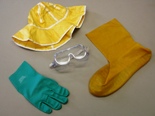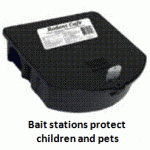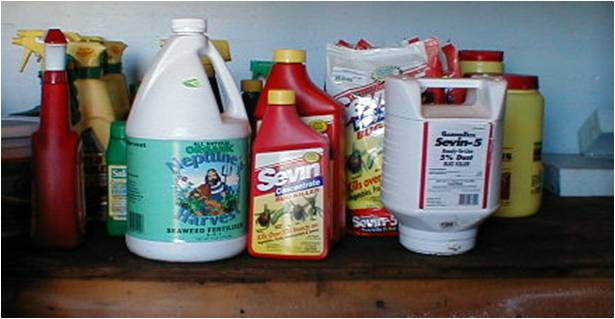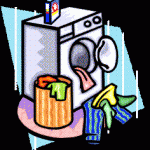Before Using a Pesticide
- Read the label thoroughly!
- Be familiar with all precautions.
- Be familiar with First Aid information.
- Put on the proper Personal Protective Equipment (PPE)
Pesticide Exposure
 Pesticides can enter the body through inhalation, ingestion, or absorption by the skin and eyes. The skin usually receives the most exposure, so it is important to cover as much of the body as possible. Make sure you wear the required protective clothing (printed on the label) before opening the pesticide container.
Pesticides can enter the body through inhalation, ingestion, or absorption by the skin and eyes. The skin usually receives the most exposure, so it is important to cover as much of the body as possible. Make sure you wear the required protective clothing (printed on the label) before opening the pesticide container.
Personal protective equipment (PPE) is clothing and other equipment worn to protect the body from contact with pesticides or pesticide residues. Wear the items of protective clothing the label requires: for example, long-sleeved shirts, long pants, overalls, nonabsorbent gloves (not leather or fabric), rubber footwear (not canvas or leather), a hat, goggles, or a dust mist filter. If no specific clothing is listed, non-absorbent gloves, long-sleeved shirts, long pants, socks, and closed shoes are recommended. Contact lenses may trap materials on the eyes; wear eye protection or remove contact lenses before mixing and applying pesticides.
is clothing and other equipment worn to protect the body from contact with pesticides or pesticide residues. Wear the items of protective clothing the label requires: for example, long-sleeved shirts, long pants, overalls, nonabsorbent gloves (not leather or fabric), rubber footwear (not canvas or leather), a hat, goggles, or a dust mist filter. If no specific clothing is listed, non-absorbent gloves, long-sleeved shirts, long pants, socks, and closed shoes are recommended. Contact lenses may trap materials on the eyes; wear eye protection or remove contact lenses before mixing and applying pesticides.
When Mixing or Applying a Pesticide
-
- Never smoke or eat while mixing or applying pesticides. You could easily carry traces of the pesticide from your hands to your mouth. Also, some pesticide products are flammable.
- Follow the “Directions for Use” on the label carefully.
- Use only for the purpose listed.
- Use only the amount directed, at the time, and under the conditions specified.
- Twice the amount will NOT do twice the job. You could harm yourself, others, or the plant/area/pet you are trying to protect.
- Always mix or dilute the pesticide outdoors or in a well-ventilated area. Only use the amount listed on the label and measure the pesticide carefully. (Never use the same measuring cups or spoons that you use in the kitchen.)
- Mix only the amount that you need for each application. Do not prepare larger amounts to store for possible future use. The pesticide will degrade and become ineffective over time. (See “Calculating the Correct Amount To Use”).
- Keep children, pets (including birds and fish), and toys (including pet toys) away from areas where you mix and apply pesticides for at least the length of time required on the label. If no time is listed on the label, wait until the pesticide has dried before reentering the area.
- If clothing becomes saturated in spray solution or contaminated with the pesticide concentrate, dispose of it immediately. Wash any parts of the body that may have been exposed to the pesticide, with soap and water, and finish the job in fresh, clean clothing.
 Indoors or outdoors, never put bait for insects or rats, mice, and other rodents where small children or pets can reach it. Pesticides that are formulated as baits (containing a feed attractant) are still pesticides.
Indoors or outdoors, never put bait for insects or rats, mice, and other rodents where small children or pets can reach it. Pesticides that are formulated as baits (containing a feed attractant) are still pesticides.- Consider selective insecticides, with a limited range of target pests, to avoid harm to non-target organisms.
Storage

Never put pesticides into food containers, such as empty soft drink, or milk bottles. Keep pesticides in their original containers – ones that clearly identify the contents. Refasten all childproof caps tightly.
If a spill occurs, clean it up promptly. Don’t wash it away. Instead, sprinkle the spill with sawdust, vermiculite, or kitty litter. Sweep it into a plastic garbage bag, and dispose of it as directed on the pesticide product label. Cleanup materials that are contaminated with a pesticide must be handled as pesticide waste.
Indoor Applications
- Make sure that the pesticide label indicates that the product can be used indoors. Never use pesticides labeled “for outdoor use only” inside a building.
- Provide adequate ventilation. If the label directions permit, leave all windows open and fans operating after the application is completed. If the pesticide product is only effective in an unventilated (sealed) room or house, do not stay there. Put all pets outdoors, and take yourself and your family away from treated areas for at least the length of time prescribed on the label.
- Apply most surface sprays only to limited areas such as cracks; don’t treat entire floors, walls, or ceilings unless the label recommends this use.
- When using total release foggers to control pests, the most important precautions you can take are:
- use no more than the amount needed and
- keep foggers away from ignition sources (ovens, stoves, air conditioners, space heaters, water heaters, etc.).
- Do not place foggers in small, enclosed places such as closets and cabinets or under tables and counters.
- When using total release foggers to control pests, the most important precautions you can take are:
- In the Kitchen
- Remove food, pots and pans, and dishes before treating kitchen cabinet
- Don’t let pesticides get on any surfaces that are used for food preparation.
- Wait until shelves dry before refilling them.
- Wash any surfaces that may have pesticide residues before placing food on them.
- Cover aquariums with plastic during pesticide applications.
Outdoor Applications
-
-
- Drift is the movement of pesticides away from the target area or plants. You should always follow all label directions for both the pesticide and application equipment to prevent drift. Also:
- Never apply pesticides outdoors on a windy day (sustained winds higher than 8 mph) or when winds are gusty or variable in direction.
- Use coarse droplet nozzles on your sprayer to reduce misting. Larger droplets help prevent drift.
- Spray as close to the target as possible, you want to get good coverage, while still preventing drift
- Do not apply pesticides on very hot days, with temperatures above 90°F. The active ingredients in some pesticides can vaporize and drift onto non-target surfaces.
- Do not over apply pesticides.
- Excessive application could cause the pesticide to run off or seep into water supplies and contaminate them. Once contaminated it is difficult or impossible to clean water sources.
- Excess spray may leave harmful residues on your homegrown fruit and vegetables, This could affect other plants, wildlife, and fish.
- Read the label to determine if the pesticide should be watered-in by irrigation
- Never mix or apply a pesticide near wellheads, stormwater drains, or bodies of water, such as creeks and streams.
- Keep pesticides away from plants and wildlife you do not want to treat.
- Some pesticides are toxic to pollinators, so read the label carefully to determine if there are application timing or other restrictions. A detailed brochure on pollinator protection can be downloaded from the Coalition for Urban Rural Environmental Stewardship (CURES).
- Do not spray bird nests when treating trees.
- Cove outdoor ornamental fishponds (do not allow to overheat).
- When applying pesticides to food crops and gardens, always check to make sure they are labeled and follow the reentry time and time-to-harvest waiting period on the label. This varies by pesticide and crop.
- Drift is the movement of pesticides away from the target area or plants. You should always follow all label directions for both the pesticide and application equipment to prevent drift. Also:
-
After Applying a Pesticide, Indoors or Outdoors
Proper cleaning procedures should always be followed after applying pesticides.
-
-
- To remove pesticide residues, use a bucket to thoroughly rinse tools or equipment that you used when mixing the pesticide. Pour the rinse water into the pesticide sprayer and dispose of it by applying to a labeled site. (See “Safe Disposal of Pesticides”.)
- Wash non-absorbent gloves and rubber boots thoroughly with hot soapy water.
- To prevent exposure to the hands, wash your gloves prior to removing them.
- To prevent tracking pesticides inside, remove and/or rinse your boots or shoes before entering your home.
- Wash any parts of your body that may have come in contact with the pesticide.
 Do not mix contaminated clothing worn during pesticide applications with other family laundry, in the hamper or the wash.
Do not mix contaminated clothing worn during pesticide applications with other family laundry, in the hamper or the wash.
- Wash all protective equipment as soon as possible following each use.
- If someone else washes the protective equipment, make certain this person is aware of safe handling and cleaning procedures.
-
Dispose of clothing saturated with diluted pesticide, or heavily contaminated with the concentrated chemical. Place the clothing in a plastic bag and in the garbage outdoors.
Evaluate the results of your pesticide use. If the pesticide did not control the pest, consider using a different chemical, a non-chemical method, or a combination of non-chemical and chemical methods (See Understanding Pest Management). Again, using more pesticide than the label recommends will NOT do a better job. Applying more pesticide than instructed by the label is illegal!
Compiled by Wayne Buhler, PhD.
